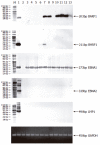Correlation of Epstein-Barr virus and its encoded proteins with Helicobacter pylori and expression of c-met and c-myc in gastric carcinoma
- PMID: 16609989
- PMCID: PMC4087508
- DOI: 10.3748/wjg.v12.i12.1842
Correlation of Epstein-Barr virus and its encoded proteins with Helicobacter pylori and expression of c-met and c-myc in gastric carcinoma
Abstract
Aim: To investigate the interrelationship of Epstein-Barr virus (EBV) and EBV- encoded proteins with Helicobacter pylori (H pylori) infection and the expression of c-met and c-myc oncogene proteins in gastric carcinoma, and to explore their role in gastric carcinogenesis.
Methods: One hundred and eighty-five gastric carcinoma tissues were detected by polymerase chain reaction (PCR)-Southern blot for EBV genome and in situ hybridization (ISH) for EBV-encoded small RNA 1 (EBER1). Gastric carcinoma with positive EBER1 signals was confirmed EBV-associated gastric carcinoma (EBVaGC). The status of H pylori infection in 185 gastric carcinomas was assessed by rapid urease test and PCR. The samples with positive PCR and urease test were defined as H pylori infection. The expression of c-met and c-myc oncogene proteins in tissues of EBVaGC and matched EBV-negative gastric carcinoma (EBVnGC) were examined by immunohistochemistry. RT-PCR and Southern hybridization were used to detect the expression of nuclear antigens (EBNAs) 1 and 2, latent membrane protein (LMP) 1, early genes BARF1 and BHRF1 in EBVaGC cases.
Results: The positive rate of H pylori and EBV in 185 gastric carcinomas was 59.45% (110/185) and 7.03% (13/185) respectively. No difference was found in sex, age, pathological differentiation, clinical stages and lymph node metastasis between H pylori-positive and H pylori-negative gastric carcinomas. However, the positive rate of H pylori infection in the antrum gastric carcinomas was higher than that of cardia and body gastric carcinomas. In our series, age, pathological differentiation, clinical stages, lymph node metastasis and location of cancer were not different between EBVnGC and EBVaGC, while the positive rate of EBV in male patients was significantly higher than that of female patients. The positivity of H pylori in EBV-associated and EBV-negative gastric carcinomas was 46.15% (6/13) and 81.40%(104/172) respectively. There was no significant correlation between EBV and H pylori infection. The c-met overexpression was significantly higher in the EBVaGC group than in the EBVnGC group. However, c-met and c-myc expression did not show significant difference between the two groups. Transcripts of EBNA1 were detected in all 13 EBVaGCs, while both EBNA2 and LMP1 mRNA were not detected. Six of the 13 cases exhibited BARF1 transcripts and 2 exhibited BHRF1 transcripts.
Conclusion: The positivity of H pylori in EBVnGCs is higher than that of EBVaGCs, but no significant correlation is found between EBV infection and H pylori infection. H pylori-positive gastric carcinoma is predominant in antrum location, while EBVaGC has a tendency of predominance in cardia/body location. EBV infection is associated with c-met abnormal expression but not with c-myc protein in EBVaGC. c-met overexpression is not induced by LMP1. BARF1 and BHRF1 may play important roles in the tumorigenesis of EBVaGC through different pathways.
Figures


Similar articles
-
[Expression of Epstein-Barr virus genes in EBV-associated gastric carcinoma].Ai Zheng. 2004 Jul;23(7):782-7. Ai Zheng. 2004. PMID: 15248912 Chinese.
-
Expression of Epstein-Barr virus genes in EBV-associated gastric carcinomas.World J Gastroenterol. 2005 Feb 7;11(5):629-33. doi: 10.3748/wjg.v11.i5.629. World J Gastroenterol. 2005. PMID: 15655811 Free PMC article.
-
Relationship between Epstein-Barr virus-encoded proteins with cell proliferation, apoptosis, and apoptosis-related proteins in gastric carcinoma.World J Gastroenterol. 2005 Jun 7;11(21):3234-9. doi: 10.3748/wjg.v11.i21.3234. World J Gastroenterol. 2005. PMID: 15929173 Free PMC article.
-
Epstein-Barr virus-associated gastric cancer: A distinct subtype.Cancer Lett. 2020 Dec 28;495:191-199. doi: 10.1016/j.canlet.2020.09.019. Epub 2020 Sep 23. Cancer Lett. 2020. PMID: 32979463 Review.
-
Clinicopathological and molecular characteristics of Epstein-Barr virus-associated gastric carcinoma: a meta-analysis.J Gastroenterol Hepatol. 2009 Mar;24(3):354-65. doi: 10.1111/j.1440-1746.2009.05775.x. J Gastroenterol Hepatol. 2009. PMID: 19335785 Review.
Cited by
-
Metabolic Control by DNA Tumor Virus-Encoded Proteins.Pathogens. 2021 May 6;10(5):560. doi: 10.3390/pathogens10050560. Pathogens. 2021. PMID: 34066504 Free PMC article. Review.
-
Association between Epstein-Barr virus infection and gastric cancer: a systematic review and meta-analysis.BMC Cancer. 2020 Jun 1;20(1):493. doi: 10.1186/s12885-020-07013-x. BMC Cancer. 2020. PMID: 32487043 Free PMC article.
-
EBV-infection in cardiac and non-cardiac gastric adenocarcinomas is associated with promoter methylation of p16, p14 and APC, but not hMLH1.Cell Oncol (Dordr). 2011 Jun;34(3):209-14. doi: 10.1007/s13402-011-0028-6. Epub 2011 May 3. Cell Oncol (Dordr). 2011. PMID: 21538028
-
Graph theory enables drug repurposing--how a mathematical model can drive the discovery of hidden mechanisms of action.PLoS One. 2014 Jan 9;9(1):e84912. doi: 10.1371/journal.pone.0084912. eCollection 2014. PLoS One. 2014. PMID: 24416311 Free PMC article.
-
Epstein-Barr virus-associated gastric carcinoma in Brazil: comparison between in situ hybridization and polymerase chain reaction detection.Braz J Microbiol. 2012 Jan;43(1):393-404. doi: 10.1590/S1517-838220120001000048. Epub 2012 Jun 1. Braz J Microbiol. 2012. PMID: 24031845 Free PMC article.
References
-
- Wu MS, Chen SY, Shun CT, Lee WJ, Wang HP, Wang TH, Chen CJ, Lin JT. Increased prevalence of Helicobacter pylori infection among patients affected with intestinal-type gastric cancer at non-cardiac locations. J Gastroenterol Hepatol. 1997;12:425–428. - PubMed
-
- Wu MS, Shun CT, Wu CC, Hsu TY, Lin MT, Chang MC, Wang HP, Lin JT. Epstein-Barr virus-associated gastric carcinomas: relation to H. pylori infection and genetic alterations. Gastroenterology. 2000;118:1031–1038. - PubMed
-
- Andal N, Shanthi P, Krishnan KB, Taralaxmi V. The Epstein Barr virus and gastric carcinoma. Indian J Pathol Microbiol. 2003;46:34–36. - PubMed
-
- Wang Y, Luo B, Wang XF, Yan LP. Detection of Epstein-Barr virus (EBV) and expression of EBV lytic genes in EBV-positive gastric carcinomas. Zhongguo Aizheng Zazhi. 2004;3:217–221.
MeSH terms
Substances
LinkOut - more resources
Full Text Sources
Medical
Miscellaneous

